Railbus
A railbus is a lightweight passenger rail vehicle that shares many aspects of its construction with a bus, typically having a bus (original or modified) body and four wheels on a fixed base, instead of on bogies. Originally designed and developed during the 1930s, railbuses have evolved into larger dimensions, with characteristics similar in appearance to a light railcar, with the terms railcar and railbus often used interchangeably. Railbuses designed for use specifically on little-used railway lines were commonly employed in countries such as Germany, Italy, France, the United Kingdom and Sweden.[1]
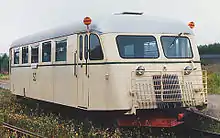
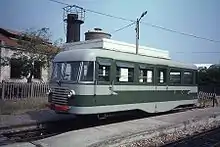
_01.jpg.webp)
Today, railbuses are being replaced by modern light DMU railcar designs.
Usage by country
Argentina
Locally manufactured TecnoTren railbuses are in use around Argentina, most notably on the University train of La Plata. They are mostly used in rural parts of the country where the tracks have not yet been repaired and so can't handle the weight of regular trains.[2]
Australia
In 1937, the NSW Department of Railways added six Waddington built four-wheel streamlined rail buses to serve on small branch lines out Cowra and Harden that did not have enough passengers to justify a rail motor.[3][4] Powered by a Ford V8 engine, they were given the designation FP1 to FP6. When the railbus service wasn't popular, several of the buses became mobile pay cars used to pay railway employees at stations and working on tracks.
In December 1941, one of these railbuses (FP 5) was destroyed when dynamite was placed on railway tracks near Yanderra. The three-man crew of the railbus were killed in the explosion. Though £2,000 of loose cash was taken, the safe in the railcar could not be opened by the robbers. No one was prosecuted for the offence.[5]
The first railbus, FP1, has been restored where it is on display at the NSW Rail Museum in Thirlmere. Another seven were built by Comeng in the 1960s.[6]
In Queensland, "RailBus service" refers to road bus service running parallel to portions of some railway lines, substituting for commuter train.
Czech Republic and Slovakia
In the Czech Republic and Slovakia, railbuses are used on less frequented rural lines. Most railbuses are based on a former ČSD M 152.0 diesel multiple unit, also known as ČD/ŽSR Class 810.
Canada
The Kaoham Shuttle utilizes DMU railbuses for its daily service between Toronto and GTA.
Syria and Saudi Arabia
Arabic railbus is in Damascus from Medan to sarouja and from riyaldh to Medina and mekkah
Germany
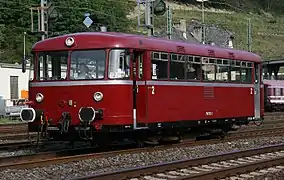
.jpg.webp)
In Germany, the Schienenbus was developed in the 1930s to fulfill the need for an inexpensive rail vehicle. It was built to standard specifications on Germany’s Reichsbahn (the predecessor to DB) to meet the demand for cost-effective services on light railways or Kleinbahnen (the Wismar railbus was a pioneer in those days.) After the Second World War, the eventually ubiquitous Uerdingen railbuses were developed by Deutsche Bundesbahn in single-engined and double-engined versions. The latter were powerful enough to haul through coaches and freight cars. Matching trailers and driving trailers were developed as well. These railbuses were a predecessor of the modern diesel multiple units. In the late 1950s, Deutsche Reichsbahn in the GDR developed the single-engined class VT 2.09 with matching trailers and driving trailers, built by Waggonbau Bautzen.
A number of serious accidents in Germany in the late 1970s involving railbuses resulted in the specification and development of larger, more robustly designed diesel railcars. Although these cars were more similar in size to the U.S. produced diesel railcars, they would not have complied with current FRA requirements, and, like their North American cousin rail diesel cars, are largely railroad-derivative designs. The DB Class 628 exemplifies the contemporary German diesel railcar. This type of car replaced the Schienenbus and locomotive-hauled train consists where possible on branch-line and main-line assignments during the 1980s and 1990s. Both the Uerdingen Schienenbus and the Bautzen railbuses have virtually disappeared from regular revenue service, but its diesel rail car successors are still widely used. DMUs of a third generation in succession after the Schienenbus are now being ordered by the hundreds in a variety of modular design combinations.[7]
India
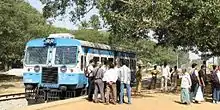
Indian Railways operates many railbuses on its branch lines. They are mostly electric. These railbuses are being replaced by EMUs due to increase in passengers.
Indonesia

Railbuses in Indonesia are built locally by INKA and used in several local rail services operated by PT Kereta Api Indonesia (KAI).
On August 5, 2012, the first railbus service in the country Batara Kresna railbus was launched to accommodate parts of Prambanan Ekspres commuter rail passengers in Central Java from Purwosari Station in Solo to Wonogiri Station in Wonogiri and vice versa.[8]
In 2014, KAI launched Kertalaya railbus in South Sumatra between Kertapati Station in Palembang to Indralaya Station in Ogan Ilir and vice versa to ease road traffic.[9]
In 2016, Lembah Anai Railbus was launched in West Sumatra to serve passengers from Kayu Tanam Station in Padang Pariaman to Minangkabau International Airport.[10]
Ireland
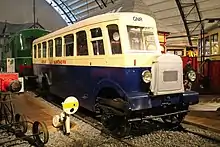
The Great Northern Railway of Ireland produced railbuses at the Railway Works in Dundalk.[11]
Japan
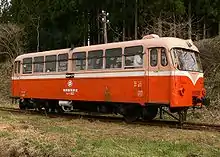
The president of JNR visited West Germany in 1953 and was introduced to railbusses there. JNR subsequently drew up a plan for railbus introduction plan in JNR, and a prototype was built in 1955. However, JNR found railbuses less reliable in daily operation as compared to standard rail equipment and discontinued their use in the 1960s. Railbuses produced by Fuji Heavy Industries were operational on the Nanbu Jūkan Railway from 1962 until the line ceased operations in 1997, though the preserved units can still be seen at Shichinohe Station.[12]
Motorization soared in Japan from the 1970s on, reducing consuming passenger numbers on local private railways. Fuji Heavy Industries Ltd. in 1982 began development of an "LE-Car" that incorporates significantly the structure of the bus, deficit local lines of JNR has been adopted by many of the railway company that local governments and private companies are operated by joint investment.
Mongolia
The Ulaanbaatar Railbus is a railbus-based public transit system in the Mongolian capital of Ulaanbaatar.
Sri Lanka
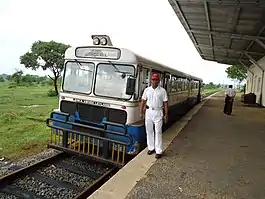
In areas without significant demand for regular commuter trains, such as in the Eastern province, railbus connects towns and cities. These buses were built by converting two buses originally built for road transport.
United Kingdom

British Rail produced a variety of railbuses as a means both of building new rolling stock cheaply, and to provide services on lightly used lines economically.
A variety of railbus known as Pacers, which were constructed in the 1980s, are still in common use today, although they are being gradually replaced.
United States
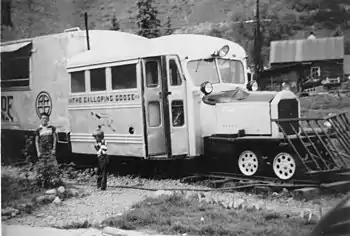
There are records of bus bodies being fitted to special Mack Truck chassis built with small four wheel bogie trucks under the engine and hood, and larger flanged steel drive wheels, as early as 1903. Osgood Bradley Car Company built one of the more popular bodies during the 1920s. Fairbanks-Morse, later a locomotive builder, offered similar conversions fitted to Dodge truck chassis in the mid 1930s, preferring to fit the truck chassis with van bodies and supply a small matching passenger coach trailer. Some railroads built their own bodies on truck or large, powerful luxury passenger car chassis. Most continued the pattern of a small two axle truck in front, and a single drive axle in the rear. One example from the 1930s, built on a White Truck chassis, is preserved at the Museum of Transportation in Kirkwood, Missouri.
After World War II a number of more modern light train concepts appeared. Few were successful, as many railroads cooperated with highway bus services to eliminate passenger trains from their branch lines. Some, like the American Car & Foundry Motorailer, blurred the line between railcar and railbus. Others, such as the Mack FCD, landed firmly in the railbus camp. Ten of the Macks were purchased by the New York, New Haven & Hartford Railroad during 1951–1952. By the time they were delivered, however, a new president was in charge, and he had little interest in serving branch lines. Only one saw regular service. All were sold to other entities such as Sperry Rail Service, or to overseas railroads.
In 1967 and 1968, Red Arrow Lines tested a GM New Look bus converted to operate on rails on its interurban routes and the Norristown High Speed Line.[13]
In 1985, SEPTA tested an imported British Rail Railbus on the now-defunct Fox Chase Line.
Gallery
 Uerdingen railbus in Germany
Uerdingen railbus in Germany Two axle British Rail Railbus in York, England
Two axle British Rail Railbus in York, England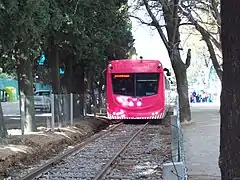 An Argentine TecnoTren railbus
An Argentine TecnoTren railbus
See also
References
- Hilding Carlsson and his Railcar Company Archived 2011-07-19 at the Wayback Machine - Retrieved on 2010-04-20
- "El Tecnotren, el transporte ecológico inventado en Argentina que une pueblos". alternativa-verde.com. 4 May 2012.
- Rolling Stock Improvements in New South Wales The Railway Magazine May 1939 page 368
- "Archived copy". Archived from the original on 2010-05-13. Retrieved 2009-12-11.CS1 maint: archived copy as title (link)
- "Archived copy". Archived from the original on 2009-09-14. Retrieved 2009-12-11.CS1 maint: archived copy as title (link)
- Order for Paybuses Railway Transportation April 1967 page 8
- "Transit Cooperative Research Program - Research Results Digest- September 2001—Number 43, page 27" (PDF). onlinepubs.trb.org. Retrieved 2010-05-01.
- "Railbus Batara Kresna Akhirnya Meluncur". August 5, 2012. Archived from the original on January 29, 2013.
- "26 November, Railbus Kertalaya Kembali Beroperasi". November 23, 2014.
- http://www.irps.or.id/kunjungan-irps-sumbar-riau-ke-pt-inka-mendampingi-kadishub-sumatra-barat/
- "Rail buses developed at Dundalk GNR Works - Independent.ie".
- "南部縦貫鉄道とは" [What is the Nanbu Jūkan Railway] (in Japanese). Retrieved 20 February 2020.
- "This bus rides rail or highway with equal ease". Railway Age, 6 November 1967 page 26
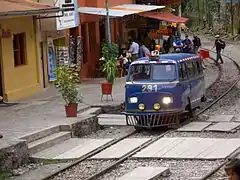
_Arriva_London_New_Routemaster_(19522859218).jpg.webp)